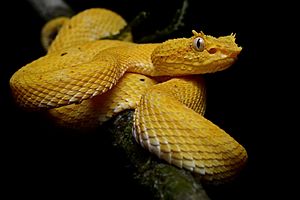Bothriechis schlegelii facts for kids
Quick facts for kids Bothriechis schlegelii |
|
|---|---|
 |
|
| Conservation status | |
| Scientific classification | |
| Genus: |
Bothriechis
|
| Species: |
schlegelii
|
| Synonyms | |
|
|
The eyelash viper (scientific name: Bothriechis schlegelii) is a type of venomous snake called a pit viper. It belongs to the Viperidae family. You can find it in Central and South America. This small snake lives in trees and comes in many colors. It's famous for the special scales above its eyes that look like eyelashes.
It is the most common type of green palm-pitviper and is often seen in zoos. The name schlegelii honors Hermann Schlegel, a German expert on birds and reptiles.
Contents
What the Eyelash Viper Looks Like
The eyelash viper is a fairly small pit viper. Adult snakes are usually between 55 and 82 centimeters (22-32 inches) long. Female snakes are often longer than males. Males can grow up to 69 cm (27 inches) long.
Head and Fangs
This snake has a wide, triangular-shaped head. Its eyes have pupils that are vertical, like a cat's. Like all pit vipers, it has large, hollow fangs at the front of its upper jaw. These fangs are like hypodermic needles and can fold back when not in use. Eyelash vipers also have special heat-sensing organs, or pits, on each side of their head. These pits are located between the eye and the nostril.
Eyelashes and Colors
The most unique feature of this snake is the modified scales above its eyes. They look very much like eyelashes. These "eyelashes" are thought to help the snake blend in with the leaves and branches where it hides.
Eyelash vipers come in many different colors. They can be red, yellow, brown, green, or even pink. They often have black or brown spots on their main color. It is hard to tell male and female snakes apart just by looking at them.
Eyelash Viper Names
The eyelash viper has many common names. Some of these include eyelash pit viper, eyelash palm viper, and horned palm viper. In Spanish, which is spoken in many countries where it lives, people call it bocaracá or víbora de pestañas (which means eyelash viper). The golden colored snakes are sometimes called oropel.
Where Eyelash Vipers Live
Eyelash vipers live in southern Mexico, through Central America, and into northern South America. You can find them in countries like Colombia, Venezuela, Costa Rica, Panama, Ecuador, and Peru. They prefer humid forests, from near sea level up to about 2,640 meters (8,660 feet) high.
Eyelash Viper Habitat
This snake likes warm, humid tropical areas with lots of plants. They usually live near a water source. One study found that eyelash vipers prefer deep, shady ravines. They rarely spend time on the ground. Instead, they prefer to stay on tree branches or vines.
Eyelash Viper Behavior
Like other Bothriechis snakes, the eyelash viper lives in trees. It has a strong prehensile tail that can grip branches. It is mostly active at night. It eats small rodents, frogs, lizards, and small birds. This snake is not usually aggressive, but it will strike if it feels threatened.
Hunting Style
The eyelash viper is an ambush predator. This means it waits patiently for prey to come close. Sometimes, it will pick a good spot and return to it every year. This happens especially when birds are migrating in the spring. Studies show that these snakes get better at striking their prey over time.
Young eyelash vipers sometimes use a trick called "caudal luring." They wiggle their tail like a worm to attract small animals. This makes the prey move closer, so the snake can strike.
There is a myth in some parts of South America that the eyelash viper winks after it bites someone. This is not true. Snakes do not have eyelids, so they cannot close their eyes or wink.
Eyelash Viper Life Cycle and Reproduction
Eyelash vipers become old enough to have babies when they are about two years old. They are ovoviviparous, meaning the mother carries the eggs inside her body until they hatch. This happens all year round in warm places.
Female snakes carry their eggs for about six months. Their lower belly gets bigger when they are pregnant. They might even stop eating in the later stages of pregnancy. A typical mother gives birth to 2 to 20 live young. The baby snakes are about 15 to 20 cm (6-8 inches) long and look like tiny versions of the adults.
Courtship Rituals
Male eyelash vipers have a special courtship dance. It is called a "dance of the adders" and can last for hours. Two males will stand upright, like a cobra, and try to push each other away. The one who falls or gets pushed away loses. These snakes are polygynous, meaning one male can mate with many females. They usually mate at night.
Eyelash Vipers in Captivity
Even though their venom is dangerous, eyelash vipers are often kept as exotic pets. They are also common in zoos around the world. Many are bred in captivity for their unique colors and patterns. Taking them from the wild is less common now, but it still happens. In general, they do well in captivity and eat mice easily.
Conservation Status
The eyelash viper has not been fully checked by the IUCN Red List. It was removed from a special list (CITES Appendix III) in 2002. While they are not currently listed as threatened, their homes could be at risk. This is because of deforestation for wood, farming, and cities.
Gallery
-
White individual in Cahuita National Park
See also
 In Spanish: Bocaracá para niños
In Spanish: Bocaracá para niños







